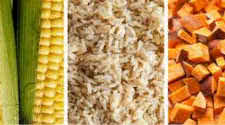Carbohydrates for Recovery: How Many Carbs & How Often?

Advanced Supplementation & Nutrition
High-intensity anaerobic exercise (read typical bodybuilding workout) is powered primarily by muscle glycogen stores. While it's true that muscle glycogen normally isn't completely depleted after weight-training sessions, it's also true that the faster you can replenish it, the
better your muscle recovery.
In fact, lack of on adequate pump after a hard set is a good indicator that you haven't sufficiently recovered from your last workout for that muscle. What's the best way to replenish glycogen stores? Since glycogen is derived from dietary carbohydrates, the amount of carts you
consume between training sessions has a direct bearing on the repletion rate of glycogen stores. Also entering into the recovery equation are the type of curbs you ingest, as well as the timing and frequently of their consumption. For example, mast studies show that the best
post-workout carts have a high glycemic index (GI), which refers to absorption rate. Simple carts with an index of 70 or above are rapidly digested, becoming available for glycogen synthesis faster than complex carbs. Sources of simple carbs include baked potatoes, fruit juices
and "wet" fruits, such as grapes. Foods with a high complex- carbohydrate content have a lower GI rating and a slower absorption rate.
A possible reason complex carbs are more slowly digested than simple curbs is their higher fiber content. The frequency of meals also affects glycogen stores, Is it better to obtain your carbs from fewer larger meals, or from more frequent smaller meals (often called grazing)?
The answer again depends on what kind of curbs you're eating. If you're' consuming mainly simple, or high-GI, carbs, eating frequency is not a factor. A new study, reported in the American Journal of Clinical Nutrition (64:115-19, 1996), confirms that it's how many carbs you eat,
not how often, that ultimately determines how fast you recover from hard training. The study compared eight triathletes with depleted glycogen levels who either consumed four large curb meals or ate smaller meals more frequently. An important point, however, is that although the
men differed in the amount of food they ate at each meal, they consumed an equivalent total number of carbs (10 grams per kilogram [2.2 pounds] of bodyweight).
The authors of the study found no significant differences between the two groups. However, the researchers do suggest that for those who consume far less than 10 grams of carbohydrate per kilogram of bodyweight as bodybuilders often do eating more frequent smaller meals may be
beneficial. In addition, consuming smaller cart meals will result in a more stable insulin release. This, in turn, will prompt the body to use the carbs for glycogen synthesis, rather than having them spill over into a fat-producing pathway.
So, for those who still carb up for contests, the number of meals you eat appears to make no difference, as long as you stick with high-Gl (simple) curbs during the first 24 hours of curb loading, which usually occurs two or three days before a contest, depending on the athlete.